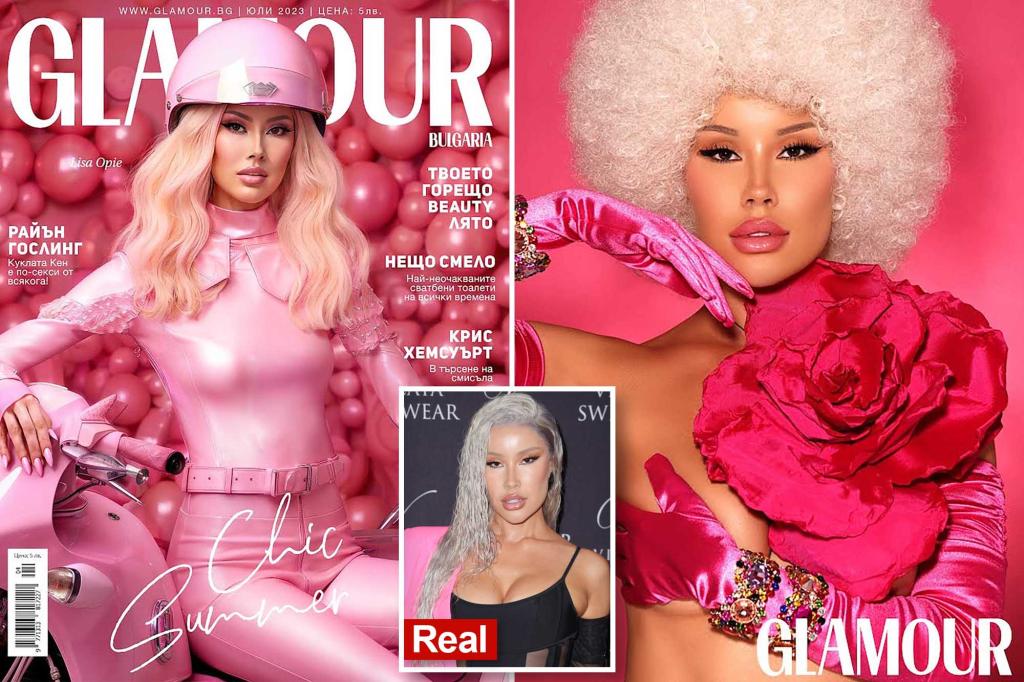Model Lisa Opie uses AI to create Glamour Bulgaria Barbie-inspired cover
Former Miss Virgin Islands, Lisa Opie, has made history by becoming the first model to have an entire magazine cover shoot created using artificial intelligence (AI). The shoot, which took just 20 minutes to complete, features Opie on the August cover of Glamour Bulgaria, transformed into a futuristic Barbie doll. Opie and her team discovered an image of a pink Barbie wearing a breastplate and decided to reach out to the artist, Fran H, who uses @ai_fashion_photos on Instagram, to incorporate Opie’s face into the images. The AI-generated shoot not only saved time but also reduced waste, as Opie only had to wear one outfit for the “mugshots” from which the images were created. The fashion industry is known for being one of the biggest contributors to global waste, and Opie believes that incorporating AI into photo shoots can help to reduce environmental impact. However, Opie is also aware of the potential risks and pitfalls of AI, particularly in relation to fake images and job displacement. She believes that legislation and regulations are necessary to protect individuals and the industry as a whole.

Model Lisa Opie harnesses the power of artificial intelligence to design a captivating cover inspired by Barbie for Glamour Bulgaria
Former beauty pageant winner, Lisa Opie, has made history by being the first model to have an entire magazine cover shoot generated using artificial intelligence (AI) technology. In just 20 minutes, Opie, who appears on the August cover of Glamour Bulgaria, worked with AI artist Fran H, known as @ai_fashion_photos on Instagram, to create around 50 images for the shoot. The concept was a futuristic Barbie theme, perfectly timed with the upcoming release of the “Barbie” movie. Opie and her team were inspired by an image of a pink Barbie wearing a breastplate, which they found online and wanted to incorporate into the shoot. They soon discovered that the image had actually been AI-generated by Fran H herself.
Opie reached out to Fran H, sending her numerous photos of her face from different angles. The artist then used AI technology to create images combining Opie’s face with various Barbie-inspired looks. While some images turned out wonky with misshapen fingers, others exceeded Opie’s expectations, presenting new ideas that she ended up liking even more than her original concept.
The AI-generated shoot not only saved time but also minimized waste. Rather than trying on multiple outfits, Opie simply wore a pink outfit for her “mugshots” so that the AI generator could identify the color and create the desired doll-like image. This sustainable approach aligns with Opie’s own business values, as she recognizes the environmental impact of the fashion industry.
The fashion industry is notorious for its contribution to global waste, with over 90 million tons of textile waste generated each year. Furthermore, 85% of all textiles are discarded even during the manufacturing process, resulting in significant environmental damage. AI-generated shoots offer a potential solution to this issue by eliminating the need for physical clothing samples and reducing waste associated with traditional photoshoots.
Despite the advantages of AI-generated shoots, Opie acknowledges the potential drawbacks. She understands that AI technology is still in its early stages and must be regulated to protect individuals’ privacy and prevent misuse. Opie herself knows people who have had AI-generated fake nudes leaked, highlighting the need for legal safeguards. She also recognizes the potential impact on job availability, as AI could replace photographers and set designers in the industry.
Overall, Opie appreciates the benefits of AI in her own business and believes it can enhance operations. However, she emphasizes the importance of careful regulation to ensure responsible use of the technology in the future. As she puts it, “I love what AI can do, but at the same time, we have to be really, really careful.”
